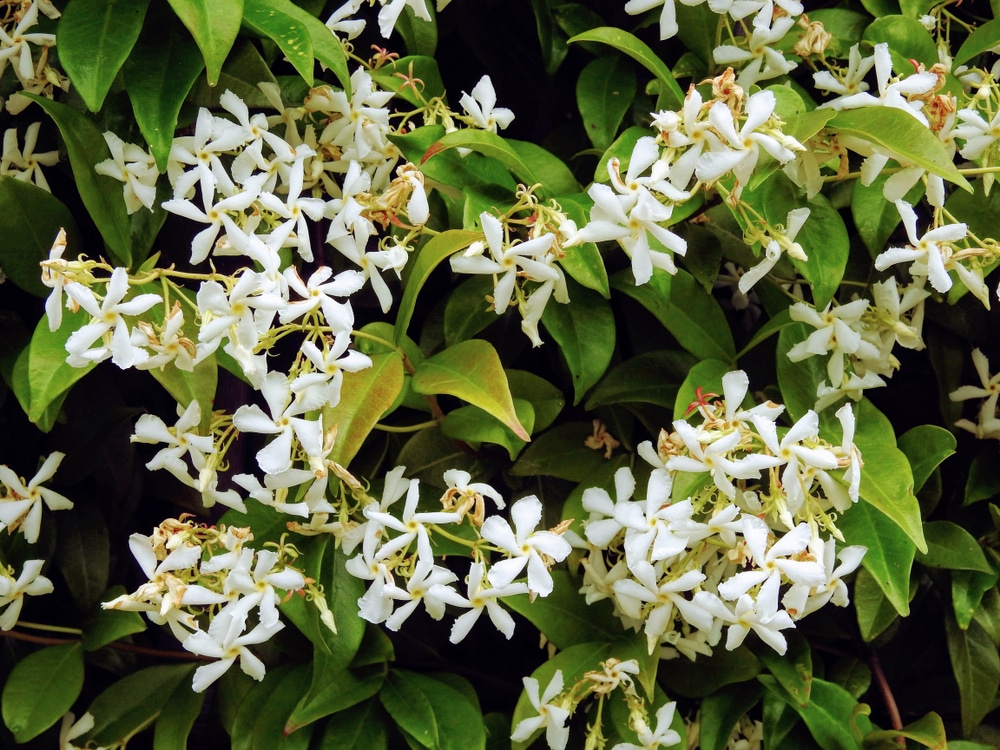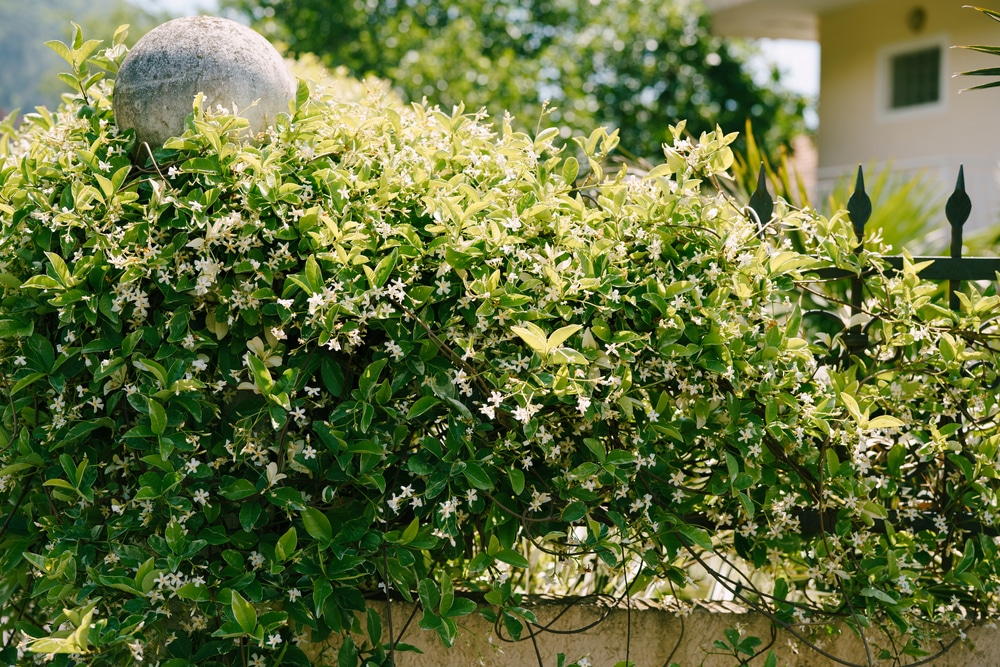Confederate Jasmine (Trachelospermum Jasminoides) is a fast-growing, evergreen vine that produces fragrant white flowers in late spring and early summer. Its star-shaped blooms and intoxicating fragrance that wafts through the air will make you turn around for a second glance.
This vine is a delight to have in your garden. It is a versatile plant that can be trained to climb walls or trellises, used as a groundcover, or even cascading over the edge of a container.

| Botanical Name | Trachelospermum Jasminoides |
| Common Name | Confederate Jasmine, Star Jasmine |
| Plant Type | Perennial |
| Flower Color | White star-shaped flowers |
| Size When Mature | 240 inches |
| Bloom Time | Spring to summer |
| Sun Requirements | Full to Partial sun |
| USDA Hardiness Zones | 7 – 10 |
| Soil PH Range | 6.0 – 7.0 |
| Soil Type | Well-drained, moist, humus-rich |
| Water Needs | Medium |
| Native Area | East and Southeast Asia |
What You Need to Know About Confederate Jasmine
This beautiful vining plant is native to East Asia, specifically China, Japan, and Korea. Its foliage is dark green and glossy, with small oval leaves that have a leathery texture. The plant’s new growth has a copper hue that fades to green as the leaves mature.
Confederate jasmine is a fast-growing plant that can reach up to 20 feet, making it an excellent choice for covering a blank wall or an unsightly fence.
Its star-shaped fragrant flowers are white with a yellow center and appear in clusters of 3-5. They bloom from late spring to early summer and have a sweet, intoxicating fragrance that can fill your entire garden. This fragrant vine is a classic Southern favorite, and it’s easy to see why. Confederate jasmine is relatively low-maintenance, fast-growing, and easy to care for.
Generally speaking, this plant isn’t considered toxic, although it might be a good idea to wear gloves while working with it. Its stems and leaves contain a sticky and milky white sap that can cause skin irritation in some people.
How to Care for Confederate Jasmine
Here’s everything you need to know about growing and caring for a thriving Confederate Jasmine:
Light
The best place to grow this plant is in an area that receives full sun to partial shade. Ideally, placing it in an area with about 4-6 hours of direct sunlight each day is best. When grown in ideal light conditions, it blooms profusely with an abundance of sweetly fragrant flowers. Although tolerant of some shade, similar to other flowering plants, partial shade also means the plant will
Water and Soil Needs
Similar to other plants, Confederate Jasmines can’t tolerate soggy soils. Rather, when established, they can go on with periods of drought without supplemental watering. Unfortunately, overwatering plants often leads to fungal diseases, root rot, and possibly the plant’s demise. In addition, waterlogged soils and roots suffocate the plant and prevent the exchange of oxygen.
Additionally, it’s tolerant of most soil types, but because it can’t tolerate soggy soils, loamy soils that drain well are ideal, with a pH range between 6.0 – 7.0.
Temperature Requirements
This climber is winter hardy in USDA zones 7-10. Overwintering this plant is essential in these colder regions as it won’t survive if left outdoors. The good news is that it’s easy to overwinter. All you need to do is prune the plant back and bring it indoors to a cool, sunny spot.
Fertilizer
The best fertilizer to use on a Confederate Jasmine is an organic compost or manure that’s been aged. You can also use a slow-release fertilizer that’s high in phosphorus to encourage blooming.
Two months before the expected frost date, cease fertilization and stop watering as much to help the plant go dormant for the winter. Resume fertilization once new growth appears in the spring.
Common Diseases
Unfortunately, Confederate Jasmine isn’t immune to the most common diseases that the majority of plants may experience. Some of these are Fusarium wilt, rust, and blight.
Primarily, these diseases may portray themselves as spots or discoloration on the leaves. Wilting of leaves and sometimes streaked stems are also telltale signs that something is wrong with your plant.
A baking soda and water solution can be used as a fungicide to prevent or treat powdery mildew, rust, and black spot. Combine 1 teaspoon of baking soda with 1 quart of water and spray the solution on the plant every 7-10 days. Alternatively, you may also use a preventive fungicide to prevent these issues overall.
Confederate Jasmine Propagation
Confederate Jasmine Propagation is as easy as growing this hardy plant. In fact, it’s considered to be one of the simplest you can propagate. You may do so through softwood cuttings taken from the current season’s growth or by layering. What does this mean? You’ll get to enjoy more of these fragrant flowering vines in no time!
Before you proceed with propagation, the first step involves preparing the soil where you’ll be planting the cuttings. The ideal soil is a mixture of one part peat moss and one part perlite in loamy soil that drains well.
Prior to taking some cuttings, you’d want to make sure that you’ve pruned the plant. This is to ensure that the diseased or dead leaves and stems are removed. After you’ve done this, take 4-6 inch cuttings that include 2-3 leaves and a stem. Make sure that you choose a healthy and mature stem for higher success rates.
When cutting the stems, cut at an angle. If you have a rooting hormone, apply it to the base of the stem. You may also dip the cuttings in water that has a small amount of rooting hormone dissolved in it.
After you’ve done this, plant the cuttings in the prepared soil. Firm the soil around the base of each cutting and water it well. Place the container in a plastic bag to create a mini greenhouse. This is optional if you have a humid environment. Place the container in indirect sunlight and keep the soil moist but not soggy. Put it in a warm, sunny spot and wait for the cuttings to take root, which usually takes 4-6 weeks.

